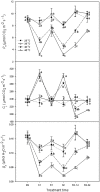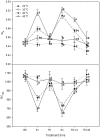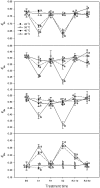Photosynthetic responses to heat treatments at different temperatures and following recovery in grapevine (Vitis amurensis L.) leaves
- PMID: 21887227
- PMCID: PMC3162573
- DOI: 10.1371/journal.pone.0023033
Photosynthetic responses to heat treatments at different temperatures and following recovery in grapevine (Vitis amurensis L.) leaves
Abstract
Background: The electron transport chain, Rubisco and stomatal conductance are important in photosynthesis. Little is known about their combined responses to heat treatment at different temperatures and following recovery in grapevines (Vitis spp.) which are often grown in climates with high temperatures.
Methodology/findings: The electron transport function of photosystem II, the activation state of Rubisco and the influence of stomatal behavior were investigated in grapevine leaves during heat treatments and following recovery. High temperature treatments included 35, 40 and 45°C, with 25°C as the control and recovery temperature. Heat treatment at 35°C did not significantly (P>0.05) inhibit net photosynthetic rate (P(n)). However, with treatments at 40 and 45°C, P(n) was decreased, accompanied by an increase in substomatal CO(2) concentration (C(i)), decreases in stomatal conductance (g(s)) and the activation state of Rubisco, and inhibition of the donor side and the reaction center of PSII. The acceptor side of PSII was inhibited at 45°C but not at 40°C. When grape leaves recovered following heat treatment, P(n), g(s) and the activation state of Rubisco also increased, and the donor side and the reaction center of PSII recovered. The increase in P(n) during the recovery period following the second 45°C stress was slower than that following the 40°C stress, and these increases corresponded to the donor side of PSII and the activation state of Rubisco.
Conclusions: Heat treatment at 35°C did not significantly (P>0.05) influence photosynthesis. The decrease of P(n) in grape leaves exposed to more severe heat stress (40 or 45°C) was mainly attributed to three factors: the activation state of Rubisco, the donor side and the reaction center of PSII. However, the increase of P(n) in grape leaves following heat stress was also associated with a stomatal response. The acceptor side of PSII in grape leaves was responsive but less sensitive to heat stress.
Conflict of interest statement
Figures






Similar articles
-
Salicylic acid alleviates decreases in photosynthesis under heat stress and accelerates recovery in grapevine leaves.BMC Plant Biol. 2010 Feb 23;10:34. doi: 10.1186/1471-2229-10-34. BMC Plant Biol. 2010. PMID: 20178597 Free PMC article.
-
Induction of cyclic electron flow around photosystem I during heat stress in grape leaves.Plant Sci. 2017 Mar;256:65-71. doi: 10.1016/j.plantsci.2016.12.004. Epub 2016 Dec 14. Plant Sci. 2017. PMID: 28167040
-
Sensitivity of photosynthesis in a C4 plant, maize, to heat stress.Plant Physiol. 2002 Aug;129(4):1773-80. doi: 10.1104/pp.002170. Plant Physiol. 2002. PMID: 12177490 Free PMC article.
-
The temperature response of C(3) and C(4) photosynthesis.Plant Cell Environ. 2007 Sep;30(9):1086-106. doi: 10.1111/j.1365-3040.2007.01682.x. Plant Cell Environ. 2007. PMID: 17661749 Review.
-
Photosynthetic carbon reduction and carbon oxidation cycles are the main electron sinks for photosystem II activity during a mild drought.Ann Bot. 2002 Jun;89 Spec No(7):887-94. doi: 10.1093/aob/mcf064. Ann Bot. 2002. PMID: 12102514 Free PMC article. Review.
Cited by
-
Effects of Coverlys TF150® on the Photosynthetic Characteristics of Grape.Int J Mol Sci. 2023 Nov 23;24(23):16659. doi: 10.3390/ijms242316659. Int J Mol Sci. 2023. PMID: 38068982 Free PMC article.
-
Differential proteomic analysis of grapevine leaves by iTRAQ reveals responses to heat stress and subsequent recovery.BMC Plant Biol. 2014 Apr 28;14:110. doi: 10.1186/1471-2229-14-110. BMC Plant Biol. 2014. PMID: 24774513 Free PMC article.
-
Transcriptomic and physiological analyses reveal different grape varieties response to high temperature stress.Front Plant Sci. 2024 Mar 8;15:1313832. doi: 10.3389/fpls.2024.1313832. eCollection 2024. Front Plant Sci. 2024. PMID: 38525146 Free PMC article.
-
Transcriptomic analysis of grape (Vitis vinifera L.) leaves during and after recovery from heat stress.BMC Plant Biol. 2012 Sep 28;12:174. doi: 10.1186/1471-2229-12-174. BMC Plant Biol. 2012. PMID: 23016701 Free PMC article.
-
Metabolic and Physiological Responses of Shiraz and Cabernet Sauvignon (Vitis vinifera L.) to Near Optimal Temperatures of 25 and 35 °C.Int J Mol Sci. 2015 Oct 14;16(10):24276-94. doi: 10.3390/ijms161024276. Int J Mol Sci. 2015. PMID: 26473851 Free PMC article.
References
-
- Berry JA, Björkman O. Photosynthetic response and adaptation to temperature in higher plants. Annu Rev Plant Physiol Plant Mol Bio. 1980;31:491–543.
-
- Quinn PJ, Williams WP. Environmentally induced changes in chloroplast membranes and their effects on photosynthetic function. In: Barber J, Baker NR, editors. Photosynthetic mechanisms and the environment. Amsterdam: Elsevier Science Publishers, Biomedical Division; 1985. pp. 1–47.
-
- Havaux M. Rapid photosynthetic adaptation to heat stress triggered in potato leaves by moderately elevated temperatures. Plant Cell Environ. 1993;16:461–467.
-
- Murakami Y, Tsuyama M, Kobayashi Y, Kodama H, Iba K. Trienoic fatty acids and plant tolerance of high temperature. Science. 2000;287:476–479. - PubMed
-
- Nash D, Miyao M, Murata N. Heat inactivation of oxygen evolution in photosystem II particles and its acceleration by chloride depletion and exogenous manganese. Biochim Biophys Acta. 1985;807:127–133.
Publication types
MeSH terms
Substances
LinkOut - more resources
Full Text Sources
Miscellaneous

